❗❗❗RECALL!!! There was a housecat in Oregon which died after eating Northwest Naturals Feline Turkey Recipe raw & frozen pet food which was infected with bird flu. THIS PET FOOD IS ALSO SOLD IN BRITISH COLUMBIA. DO NOT FEED YOUR CAT THIS FOOD. (Yes, there has been a recall.)
COVID-19
This paper from Germany (2024-12-23) found that two different variants of a gene which correlate both with susceptibility to dying from COVID and from getting Long COVID. These are the HLA-G gene variants UTR-3 and rs17875408 (AKA +3422), don’t worry, those will not be on the exam.
HLA-G is involved in regulating the immune system, and this might give us clues on how aggressively to treat someone and/or what drugs to investigate.
Long COVID
⭐❗There is a new Canada-wide Long COVID study looking for participants! If you or someone you know has Long COVID, check out the RECLAIM study.
This case study (2024-01-01?) reports that a 43-year old woman with Long COVID was helped significantly with enoxaparin (a blood thinner). (The paper did not specify what country the woman lives in.)
This paper from Sweden (2024-12-27) reported on long-term effects in university students who had had COVID-19 infections. They found:
- ⭐ Some effects lasted for at least four years, although they differed by gender: women were likely to have persistent fatigue and men more likely to have persistent memory issues.
- COVID Classic variant caused the most trouble and Omicron the least.
- The variant did not appear to affect the severity of acute COVID-19.
- Vaccination gave some protection against long-term consequences.
⭐ This paper from USA (2024-12-18) reported on a study of people who took PCR tests every 24 to 48 hours for 10-14 days some time between October 2021 and February 2022. The study did a followup in August 2023. They found:
- They found a link between symptoms during the initial, acute phase of COVID and later Long COVID. The following symptoms during the acute phase gave the following higher risk of getting Long COVID:
- abdominal pain: 5.41x;
- nausea: 3.01x;
- body aches: 2.58x.
- 34.3% reported Long COVID.
- 77.2% of people with Long COVID did not return to their pre-COVID health levels within 8–60 weeks after infection. That means that 26.5% of the all the people who got COVID-19 did not return to their pre-COVID health levels.
- Slower recovery from the acute phase correlated with a higher risk of Long COVID for women only. Men didn’t see a relationship between recovery time and Long COVID.
- Slower recovery from the acute phase correlated with more Long COVID symptoms.
❗This pre-pandemic paper from US (2019-05-21) reports that 36.1% of women with ME/CFS had endometriosis!
This paper from UK (2024-12-03) reports that 15.7% of Long COVID patients had objective cognitive impairment as measured by one test; by another test, 89.5% were impaired on at least one task, “primarily in the domains of attention, executive function and processing speed”.
COVID-Related Excess Sickness and Death
⭐❗❗This paper (2024-12-22) using data from Brazil says that hospitalized pregnant women who had COVID-19 had a 48% higher risk of going on a ventilator, and at least one dose of vaccine dramatically lowered a number of risks:
- 86% lower chance of maternal sepsis;
- 73% lower risk of ICU admission;
- 40% lower risk of going on a ventilator.
The mom getting a vaccination also reduced risks for the babies:
- 38% lower risk of going into the neonatal ICU;
- 40% lower risk of neonatal respiratory distress.
In this article (2024-12-27), some of the same authors as of the previous study discuss what happened to babies who had been in the womb when their moms got COVID, and it’s not good. 14% of the infants showed signs of developmental problems. At 6-8 months, 12% failed to reach developmental milestones. At 28 months, 11% of the children tested positive for autism (compared to the historical average of 1-2%). (NB: I can’t tell if it is the exact same babies as in the first study or if it is a different cohort. The second study has not been published yet.)
⭐❗This tweet (2024-12-29) points out that accidental deaths in the USA spiked after the start of the pandemic:
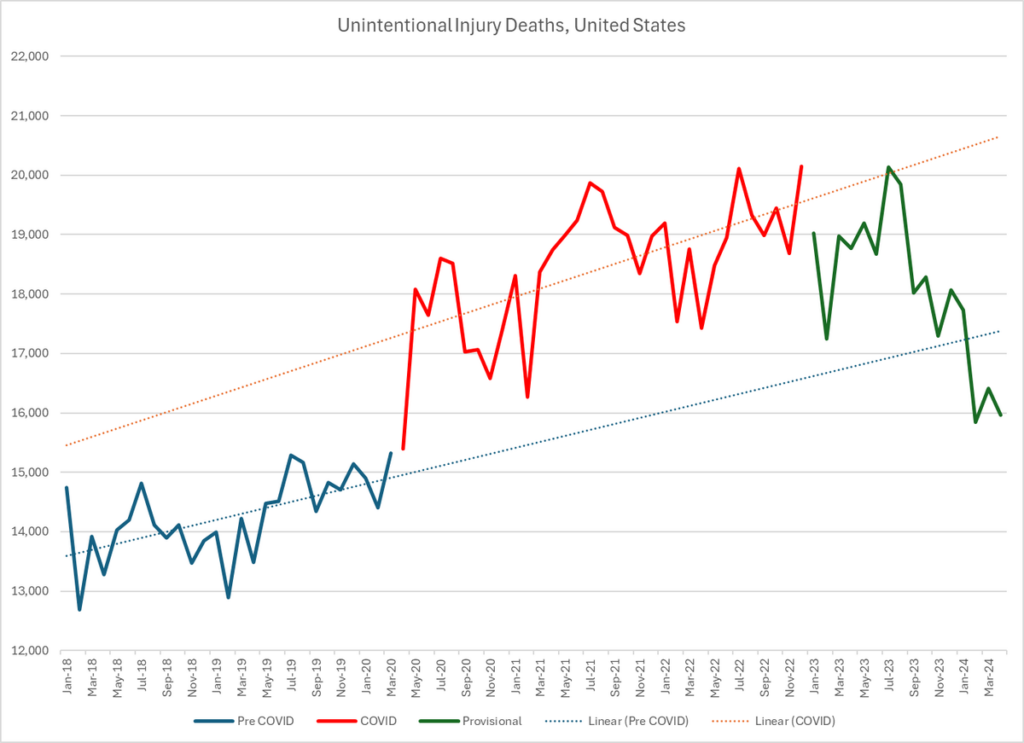
Note although the green line is going down, that data isn’t complete yet — so the green line is misleading.
The author speculates that the accident rate went up because of COVID-related cognitive issues.
⭐ This paper from Saudi Arabia (2024-12-30) reports on the response of young adults (university students) to COVID-19 infections. They split the students into three groups: “Recovered” for those who fully recovered within two weeks, “Prolonged” for those who recovered within four weeks, and “Persistent” for those who took more than four weeks to recover.
They found that the acute phase symptoms different between the three groups:
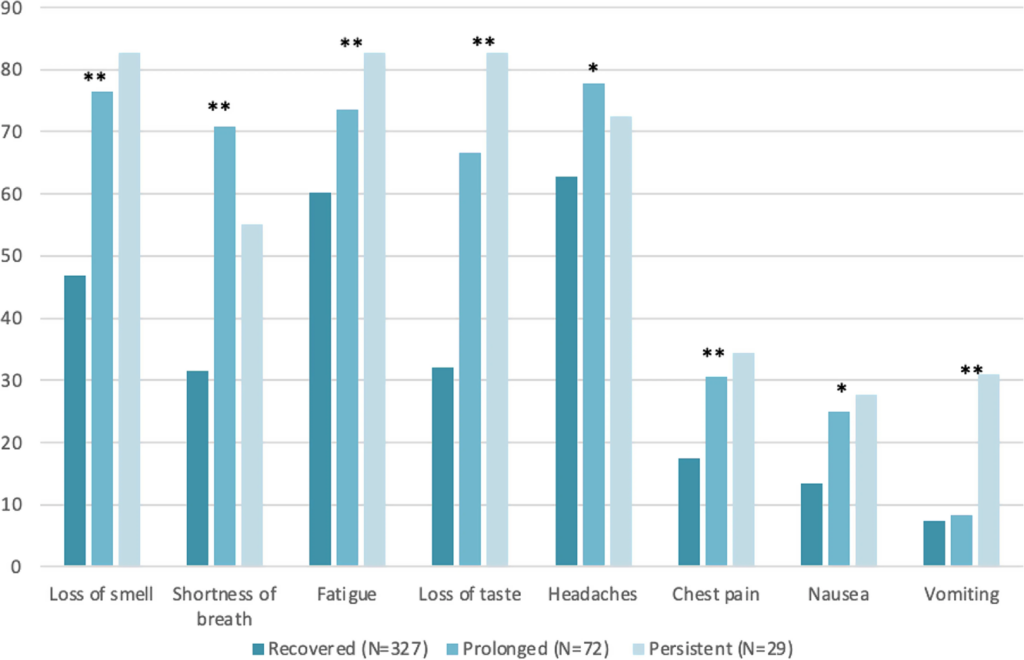
People who recovered quickly had fewer symptoms; people who took longer to recover had more symptoms.
This paper using data from Sweden (2024-12-24) reports that kidney function declines more after COVID-19 than it does after influenza. Kidney function decline was worse for people hospitalized for COVID-19 vs. non-hospitalized with COVID-19, but hospitalization status didn’t make much difference for influenza.
Transmission
This paper from the Netherlands (2024-12-28) carefully examined how COVID-19 spread, both in families and in schools. They found that the probability of two people from the same family (parent-child or child-child) catching COVID-19 at the same time was ~23%, but the chance of two students going to the same high school catching COVID-19 at the same time was only 1.65%. The probability of catching COVID-19 at the same time was even lower for children who lived geographically close but didn’t go to the same school.
You might be saying, “daaaaaaa-yum, Dr. Henry was right that schools didn’t drive spread!” but wait: The paper notes “even small increases in school-related infection probabilities can trigger large-scale outbreaks due to the dense network of interactions in these settings”. Also, how likely are two students at a high school to see each other? Even at my ridiculously tiny high school, there were a lot of students who I barely ever saw. If someone weren’t in my grade, if they weren’t in my classes, then I wouldn’t have had much of a chance to get infected by them.
Vaccines
This update (2024-12-12) reports that the Europe’s approval group has recommended authorizing LUNAR-COV19 (trade name Kostaive) by Arcturus Therapeutics, a self-amplifying mRNA vaccine (saRNA).
Previous trials of LUNAR-COV19 showed it was significantly more durable than the Pfizer COVID-19 vax, with about half as many severe adverse reactions as Pfizer.
There was a saRNA vax approved in Japan, but Arcturus’ vax is the first next-gen vax that’s going to get approved in Europe. (I believe that just about everything that gets recommended gets approved.)
⭐ This paper (2024-12-11) reported that an intranasal version of NDV-HXP-S which was reformulated to be based on the XBB.1.5 worked really well. None of the hamsters given the XBB.1.5 version then given a dose of COVID-19 and none of the unvaxxed hamsters that were cohoused with the exposed hamsters got sick. Meanwhile, with the original NDV-HXP-S vax and Omicron exposure, about half of the vaccinated hamsters got sick and all of the co-housed hamsters got sick. (NB: It was not clear to me if the hamsters vaccinated with the COVID Classic version of NDV-HXP-S were vaccinated intranasally or intramuscularly.)
The new vaccine worked well even with only one dose!
This paper (2024-12-04) reported on studies in mice and hamsters of a viral-vectored S1 protein subunit vaccine. They found that intranasal delivery worked better than intramuscular.
⭐⭐⭐❗❗❗This paper (2024-11-27) reports on a vaccina (“cowpox”) vectored vaccine called rTTV-RBD-HA2 which had receptor binding domains from SARS-CoV-2, SARS-CoV, and MERS-CoV and the hemagglutinin (HA) stalks from the pdmH1N1 and nH7N9 influenza vaccines.
One intramuscular dose followed by two intranasal boosts of rTTV-RBD-HA2 vaccine protected mice really stunningly well from COVID Classic, XBB, H1N1 flu, and H3N2 flu! Just look at these graphs!!
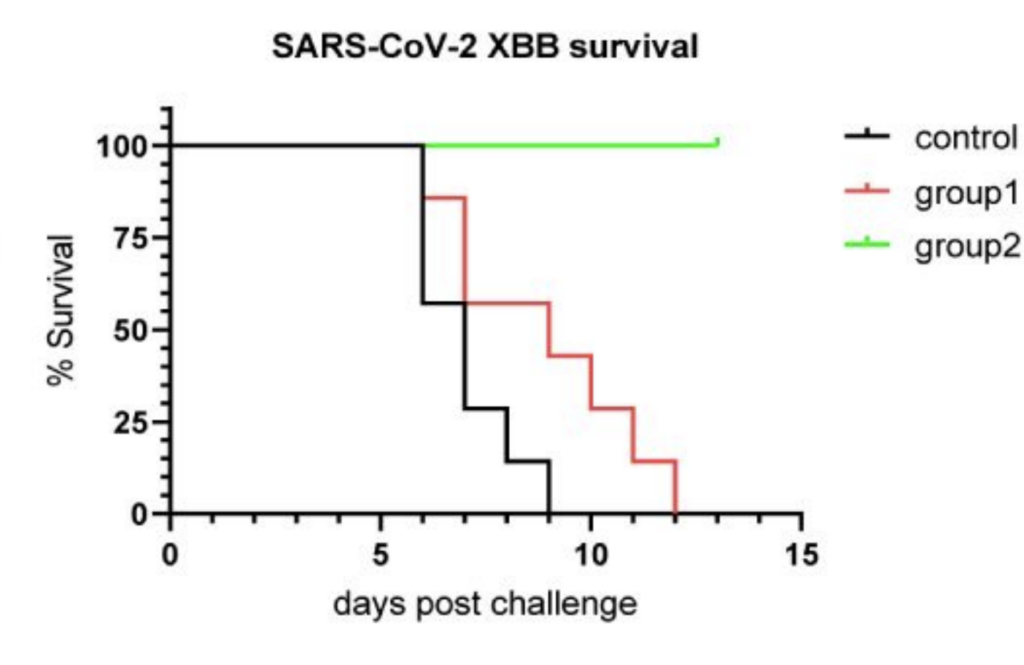
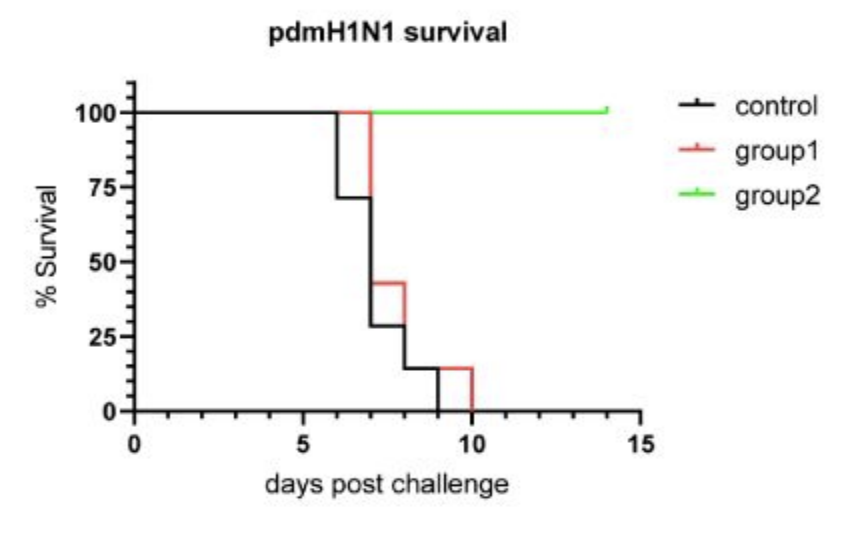
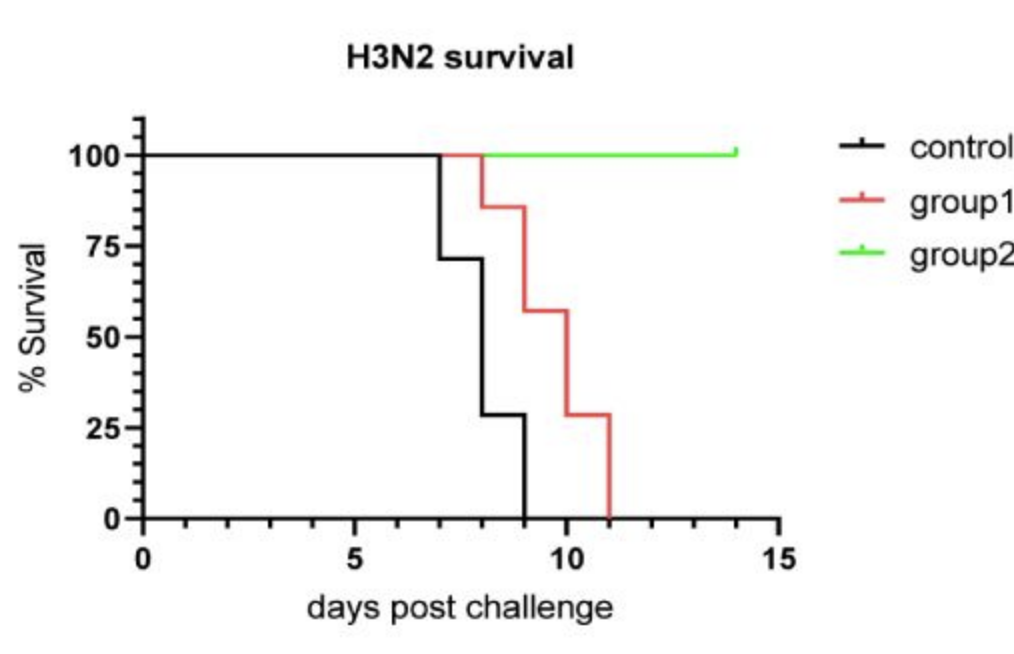
Alas, the vax is from China, so we probably won’t be seeing it in Canada any time soon.
Attention/note! There was not a H3 stalk in the vax. It gave protection against H3N2 because the H7 HA is closely related to the H3 HA (and H4, H14, H10, and H15 HAs). Meanwhile, the H1 HA protein is related to the H5 protein (and H2, H6, H8, H11, H13, H12, H16, H17, and H18 HAs). That means that this vax has a chance of giving protection against bird flu — H5N1 –too!
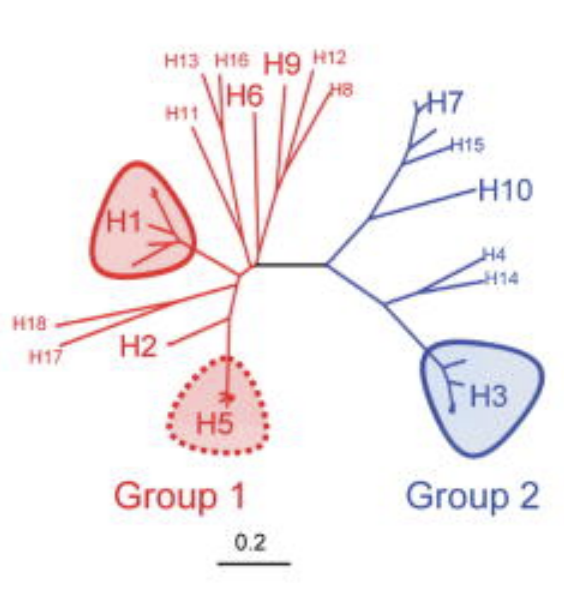
I do wonder a little bit if it would work for old people. Old people (like me) have all been vaccinated for smallpox, which also used the vaccina virus. I think there is a risk that my immune cells would recognize the vaccina virus as an enemy and attack it before the immune system had a chance to train on it.
⭐ This paper (2024-12-15) reports a relatively complicated set of vaccination trials which varried intranasal/intramuscular, adjuvanted/unadjuvanted, same/different first and second shot, and self-amplifying (saRNA) / protein subunit versions of the Indovac vaccine. (Indovac was developed by Baylor University (and given away patent-free!) and is manufactured by an Indonesian company and approved for use in Indonesia.) They didn’t try all possible combinations of vaccines/adjuvanted/delivery method, though.
They found that the unadjuvanted protein subunit worked better when given nasally, but that the adjuvanted version worked better when given intramuscularly.
Overall, they found that the combo which worked best was a first dose of the intramuscular (unadjuvated) saRNA vaccine followed by intramucular adjuvanted protein subunit.
Treatments
⭐ This article (2025-01-02) reports on a study from Iran (which I couldn’t find) which said that patients in critical care with COVID-19 who took licorice root extract spent 13.1 days in hospital, while the placebo group spent 25 days in hospital.
Licorice root extract is apparently used a lot in Chinese medicine, and there are a lot of articles about licorice and COVID-19; I put references on my Treatments page.
Recommended Reading
This article (2024-12-29) talks about the impact of Long COVID on fertility.
My fave vaccine blogger has three new posts out: one in her series of what’s-up-with-COVID-19-vaccines (2024-12-31), one explaining self-amplifying RNA (saRNA) vaccines (2024-12-31), and one very thorough post countering vaccine disinformation (2024-12-28). I have pulled some of the most interesting bits from the former, but the latter two are too detailed to summarize.
In this long interview transcript (2024-12-30), a doctor talks about why COVID-19 is bad and what we can do about it. Longtime readers of this blog might not see anything new, but it’s a very nice, thorough, well-argued tying together of a lot of lines of thought in one place.
This article (2025-01-02) reports from a conference formed to talk about how to prevent the next pandemic.
H5N1
Transmission
This article (2025-01-02) reports that the US federal government is now requiring poultry farms to take precautions against H5N1 or else they won’t be compensated for culling their flock. I worry that this means farmers will be incentivized to hide infections. (Also: why don’t they require that all cattle from an infected dairy farm be culled?)
⭐ This report from US CDC (2024-12-27) discusses the genomic sequencing of the virus retrieved from the severe Louisiana case who apparently caught H5N1 from their backyard chickens. They found a few somewhat troubling mutations which make binding to mammalian cells easier (including one which the Fraser Health teen also had). They noted, however, that most of the genomes at that location were avian.
Remember that when someone has a virus in them, it’s not one virus: there are millions (billions?) of virus particles running around. It looks like some of those virus particles had mutated to be easier to spread in mammals, but most of the virus particles running around were still avian. Most of the viruses matched the infection from the chickens, in fact.
They said that those mutations are rare in people, and usually only happen in severe cases.
If I understand correctly, they also found that the mutations made the patient’s virus very similar to other viruses that we humans had already logged, including ones “that are already available to manufacturers, and which could be used to make vaccines if needed”.
While it’s unsettling to find these mutations, it makes it pretty clear that the patient caught it from their chickens and not from another human (or even another mammal), which is encouraging.
⭐❗❗This press release (2024-12-23) reports that two more housecats from two different households died from H5N1, this time in Santa Barbara County. I think that brings the total number of housecats to ten, but I can’t find a place where that’s being tracked.
⭐ In addition to the Northwest Naturals brand 2lb Feline Turkey Recipe raw frozen pet food recall, this article (2025-01-01) reports that they have also found H5N1 in another raw food pet food in California, Monarch Raw Pet Food (which is not sold in BC). Don’t feed your cat raw food right now!
This article (2024-12-30) reports that the US now has found 912 infected dairy herds across 16 states, with 697 in California.
A quick reminder that California has roughly 1/8th of the US population.
Pathology
⭐ This Letter to the Editor from BC (2024-12-31) gives details on the case of the BC teen who got bird flu. According to this Letter, the Fraser Health teen infected with bird flu was a 13 year-old girl with a BMI over 35, and boy howdy, did she get hammered by bird flu!
The Letter doesn’t say how she is doing now. I hope 2025 treats her better than 2024 did.
Mystery Disease
⭐ This press release from the World Health Organization (2024-12-27) reports that the mystery disease appears to be severe but understood respiratory infections, made worse by malaria and malnutrition. (They did not, however, discuss the case of the man who died with hemorrhagic fever symptoms.)
